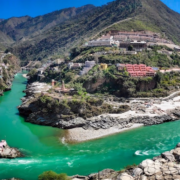
Kedarnath: A Sacred Journey to the Heart of the Himalayas
Nestled in the Garhwal Himalayas of Uttarakhand, India, Kedarnath Dham is one of the most revered and sacred pilgrimage sites for Hindus. Situated at an altitude of 3,583 meters (11,755 feet), Kedarnath is renowned for its ancient Shiva temple, breathtaking natural beauty, and spiritual significance. The journey to Kedarnath is not just a physical trek through rugged terrains but also a deeply spiritual quest that attracts thousands of devotees and tourists every year.
Historical and Mythological Significance
The Kedarnath Temple, dedicated to Lord Shiva, is one of the twelve Jyotirlingas and the most important of the Panch Kedar temples. According to legend, after the Kurukshetra war, the Pandavas sought to atone for their sins by worshiping Lord Shiva. Shiva eluded them and took refuge at Kedarnath, transforming himself into a bull. When the Pandavas pursued him, he dived into the ground, leaving behind his hump, which became the sanctum of the temple. The remaining parts of his body appeared in different locations and are worshipped as the other Panch Kedar temples.
The temple itself is believed to have been constructed by the Pandavas and later renovated by Adi Shankaracharya in the 8th century. The temple’s architecture is a marvel, built from large, heavy stones that have withstood the test of time and harsh weather conditions.
The Kedarnath Temple
The Kedarnath Temple stands amidst majestic snow-capped peaks and is built on a rectangular platform surrounded by the Mandakini River. The temple’s inner sanctum houses the conical-shaped Shiva lingam, representing Lord Shiva in his Sadashiva form. The exterior and interior walls of the temple are adorned with intricate carvings depicting various Hindu deities and mythological scenes.
The temple is open to devotees from April to November, during which thousands of pilgrims undertake the arduous journey to seek blessings. The winter months see the temple covered in a thick blanket of snow, and the idol of Lord Shiva is moved to Ukhimath, where it is worshipped for the remaining part of the year.
The Pilgrimage and Trek
Reaching Kedarnath is a pilgrimage in itself, involving a trek through scenic yet challenging terrain. The journey typically begins from Gaurikund, which is about 16 kilometers from the temple. The path to Kedarnath is steep and winding, traversing dense forests, gushing streams, and picturesque valleys. For those unable to trek, there are options of hiring ponies, palanquins, or even helicopter services to reach the shrine.
The trek is not just a physical challenge but a spiritual journey, where the chanting of hymns, the sound of temple bells, and the breathtaking natural beauty create an atmosphere of devotion and serenity. The journey to Kedarnath is considered a test of faith, resilience, and endurance, with the destination offering a profound sense of peace and spiritual fulfillment.
Natural Beauty and Surroundings
Kedarnath’s location in the heart of the Himalayas makes it one of the most beautiful and serene pilgrimage sites in India. The region is surrounded by towering peaks like Kedarnath, Kedar Dome, and Bharat Kund, which add to the divine aura of the place. The Mandakini River flows gracefully through the valley, adding to the tranquility and spiritual ambiance.
The area around Kedarnath is dotted with several picturesque spots, such as Vasuki Tal, a high-altitude lake surrounded by snow-covered mountains, and the Bhairav Temple, located on a hill overlooking the Kedarnath Temple. These sites offer stunning views and a sense of peace, making them popular with trekkers and nature enthusiasts.
The 2013 Floods and Reconstruction
In June 2013, Kedarnath witnessed one of the most devastating natural disasters in its history. Flash floods and landslides caused by a cloudburst led to extensive damage to the temple and surrounding areas, resulting in significant loss of life and property. The temple itself, however, withstood the deluge, which many devotees considered a divine miracle.
In the aftermath of the disaster, extensive reconstruction and rehabilitation efforts were undertaken to restore the temple and infrastructure. The resilience of the local community and the collective efforts of various organizations have brought Kedarnath back to its former glory, ensuring that pilgrims can continue their sacred journey to this revered shrine.
Spiritual and Cultural Impact
Kedarnath is not just a destination; it is a journey that embodies the essence of devotion, faith, and spirituality. The pilgrimage to Kedarnath is considered one of the holiest endeavors a Hindu can undertake, believed to bring spiritual merit and the blessings of Lord Shiva. The temple and its surroundings are imbued with a sense of sacredness that transcends religious boundaries, attracting people from all walks of life seeking peace and spiritual solace.
Conclusion
Kedarnath Dham is a timeless symbol of faith, devotion, and resilience. Its stunning natural beauty, coupled with its profound spiritual significance, makes it a unique and revered pilgrimage site. Whether one is drawn by religious devotion, the allure of the majestic Himalayas, or the quest for inner peace, a journey to Kedarnath is an experience that leaves an indelible mark on the soul.
Recent Posts
Exploring Pangot: A Tranquil Bird Watcher’s Paradise in Uttarakhand
Devprayag: The Sacred Confluence of Rivers and Cultures
Rudraprayag: A Confluence of Spirituality and Natural Beauty
All Categories

Thailand




